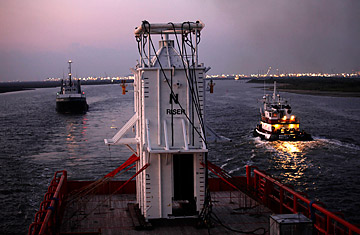
The Joe Griffin leaves Port Fouchon, Louisiana, as it enters the Gulf of Mexico carrying a so-called "dome," a containment vessel, to the rig collapse site. It will be used to help bottle up and reduce 85% of the leakage of Deepwater Horizon oil.
With the first definitive reports of crude making landfall, fouling the shores of Louisiana's outlying Chandeleur Islands on May 6, the response to the Deepwater Horizon oil spill has moved to a new and more serious level.
Even as volunteers and private contractors helped spread booms to protect Lake Pontchartrain and the city of New Orleans from the oncoming oil, BP on Friday began lowering a 70-ton containment dome over the first of three leaks from the Deepwater Horizon wreck, 5,000 feet below the ocean's surface. If the operation is successful, the dome — and two others that will be deployed over the weekend — will channel oil up to ship on the surface, and could reduce the leakage of oil by some 85%.
If it fails though — and the technique has never been tried in water this deep — the leak will continue, and could even grow. "I want to manage everyone's expectations," said Coast Guard Rear Admiral Mary Landry, the federal on-scene coordinator for the spill response. "This is not something we've tried before in this water, and it may or may not work."
But for the worried residents of the Gulf Coast — still nervously waiting for the "oilpocalypse" to reach their shores — much of the damage has already been done. The fishing industry was the first to feel the hit, and on Friday the National Oceanic and Atmospheric Administration (NOAA) expanded the closure of oil-affected commercial and recreational fishing until at least May 17. "NOAA scientists are on the ground in the area of the oil spill taking water and seafood samples in an effort to ensure the safety of the seafood and fishing activities," said NOAA Administrator Jane Lubchenco in a statement. "NOAA stands shoulder to shoulder with Gulf Coast fishermen and their families during these challenging times."
Once again, times are challenging for the Gulf and for New Orleans. Although the oil-affected area represents less than 5% of the federal Gulf waters, public fear of seafood that has come into contact with oil could be enough to badly damage the local seafood industry. And that, in turn, would hit hard the famed restaurants of New Orleans, which depend on the local catch — just as the Crescent City, which lives on tourism, depends on its restaurants. "This impacts our business, but it impacts the culture of New Orleans itself," said John Burns, the co-owner of Jack and Jake's Market in the city. "This is a big part of who we are."
In the meantime, the spill has already begun to impact the future of offshore drilling in the U.S. On May 6 the Department of Interior announced a nationwide halt to the granting of any permits for new exploratory oil well drilling, pending a 30-day investigation into the cause of the Deepwater Horizon accident. The safety report is expected by May 28.
The Interior Department also suspended planned lease sales for drilling off the coast of Virginia, one Atlantic state where politicians had been mostly in favor of expanded oil and gas exploration. The politics of the oil spill makes new exploration off the Atlantic or Pacific Coast seem unlikely now, and the fate of drilling in Alaska — where the energy company Shell is planning on exploratory drilling in the far northern waters of the state this summer — is still up in the air. Salazar told reporters on May 6 that they "will not get those permits until we have the opportunity to complete this review. We will see what lessons we learn between now and then and at that point will make a decision about how we're going to move forward."
With Alaskan waters containing an estimated 17 billion barrels of oil, the battle over whether or not to drill is far from over. But for now the focus is still on the Gulf of Mexico and the wreck of the Deepwater Horizon. Over the past few days responders have had a rare stretch of good luck — clean weather has given them the chance to skim thousands of barrels worth of oil and water, while using fire booms to perform in-situ burns on the oil slick. The weather is expected to say clear through the weekend, and BP has said it has put in place more than a million feet of boom to protect the Gulf coastline.
But everyone acknowledges that if the oil can't be stopped at the source, no amount of protection will keep the Gulf coast safe. "Our goal from the start is to stop the flow of oil and minimize its impact," said Doug Suttles, BP's chief operating officer. Without achieving the first, they have no hope for the latter.
